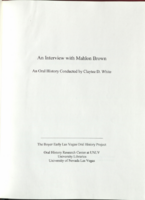Search the Special Collections and Archives Portal
Search Results

Transcript of interview with John F. Cahlan by Larry DuRussel, July 02, 1975
Date
1975-07-02
Archival Collection
Description
Larry DuRussel interviews John Cahlan (b. 1902) about the history of Nevada. Cahlan discusses how Las Vegas was developed, how Nellis Air Force Base was built and what it was used for, and how water was originally supplied to Las Vegas. Cahlan also mentions the various Hollywood stars he met during his career as a journalist for the Review Journal. DuRussel also asks Cahlan about the atomic testing conducted in Nevada.
Text

Transcript of interview with Edith Giles Barcus by Tara L. Shepperson, March 17, 1977
Date
1977-03-17
Archival Collection
Description
Tara L. Shepperson interviews local antique store owner Edith Giles Barcus in the living room of her home about Goldfield, mining, purple glass, thirst in the desert, her family history, and her birth in Colorado.
Text

Transcript of interview with Marjorie Barrick by Mary Beth Nitzchke, March 13, 1981
Date
1981-03-13
Archival Collection
Description
Mary Beth Nitzschke interviews Marjorie Barrick (b. 1917) in her den at her home about the sociological view of Nevadans in the gaming industry. Barrick also discusses UNLV’s beginnings, Las Vegas history, founding Child Haven, Owning Flamingo and the Fremont, “the hotel people,” and the lack of cultural activities in the 1950s.
Text

Transcript of interview with Mahlon Brown by Claytee D. White, December 16, 2003
Date
2003-12-16
Archival Collection
Description
Attorney Mahlon Brown begins by talking about his family. His dad was a senator for Nevada, his grandmother was an "amazing, strong, powerful, and insightful" woman, and his mother he describes as beautiful, well-read, and a music lover. He reminisces about his undergraduate days at Howard University and the job he held as a Capitol policeman during the sixties. This included guarding JFK's casket. Mahlon recalls many notable Nevadans that he knew personally, worked closely with, or came up against in meetings or trials. He shares many anecdotes and stories about his contact with Judge Foley, Ronald Pollock, Kenny Guinn, Father Vitali, and Earl White, to mention just a few. He also shares memories of women like Ruby Duncan, Mary Wesley and Maya Miller. Attorney Brown describes the duties of the office of Justice of the Peace which he held for a few years, as well as some of the cases he and Jack Anderson handled when they worked in Legal Services. He also describes the poverty workshop he and Jack ran for three or four years, which gave welfare recipients a chance to air their opinions. Mahlon shares his opinions, insights, and firsthand knowledge of the Mob, Howard Hughes, Mayor Oscar Goodman, Malcolm X, James Brown, integration on the Strip, and many other topics. His personal connections and lengthy history of working and living in Las Vegas make for knowledgeable and entertaining reading.
Text

Transcript of interview with Helen M. Baucum by William D. Marshall, February 28, 1975
Date
1975-02-28
Archival Collection
Description
William D. Marshall interviews Helen M. Baucum (b. 1920) at her office, about her life as a local Nevadan. The interview covers Southern Nevada, Las Vegas, and Henderson.
Text

Transcript of interview with Charles A. Baumert by James M. Greene, October 31, 1975
Date
1975-10-31
Archival Collection
Description
James M. Greene interviews Charles A. Baumert (b. 1908) at his home in Dixie Deer Estates, Utah vicinity-Pine Valley, Utah, (Central Utah), about Hoover Dam work, Boulder City history, and closing Six Companies Inc. operations at Hoover Dam.
Text

Transcript of interview with Paul A. Beach by William Gekakis, February 17, 1976
Date
1976-02-17
Archival Collection
Description
William Gekakis interviews his friend airline pilot Paul A. Beach (b. 1922) at his home, about Las Vegas, Nevada history. Beach, who moved to Las Vegas in 1952, covers topics including housing, physical boundaries of the city, the airport, church, transportation, tourist recreation, the economy, Nellis Air Force Base, the Strip, industries, presidential visits, the Korean War, atomic tests, and the educational system.
Text

Transcript of interview with Alison and Michael Chambers by Claytee D. White, October 03, 2013
Date
2013-10-03
Archival Collection
Description
Michael and Alison Chambers might be recent Las Vegas residents, but they have history with the city, having eloped in Las Vegas on December 24, 1982. After spending their lives in California, with a brief stint in western Massachusetts, the couple moved to Las Vegas twenty years later. Both Michael and Alison grew up in the Los Angeles area, graduating from University of Southern California and Mills College respectively. Although Michael received his degree in architecture, his career trajectory transitioned to the financial industry. When Michel and Alison visited the McNeil neighborhood while house-hunting last year, it was immediately clear that the community would be their new home. They both enjoy the close-knit nature of the community, and have become active in the neighborhood association and its social activities. The Chambers’ have quickly integrated into the community, taking advantage of the city’s offerings, including the Art District, downtown renovations, photography club, hidden restaurant gems, and locals discounts.
Text

Transcript of interview with Bill Belknap by R. J. Johnson, February 12, 1979
Date
1979-02-12
Archival Collection
Description
R. J. Johnson interviews Bill Belknap (b. 1920) at his home about Southern Nevada through the eyes of an established local photographer. Belknap discusses Colorado River, Nevada State Advisory Commission, WWII, Henderson Power Plant during WWII, El Rancho 1940s, Tule Springs Archaeological Project 1966-1967, Atomic Testing, Lake Mead, Boulder City, music and Jazz in Southern Nevada, teaching at UNLV, photography, and the Grand Canyon.
Text

Transcript of interview with Rex A. Bell Jr. by Craig Klatt, March 1, 1977
Date
1977-03-01
Archival Collection
Description
Craig Klatt interviews Rex Bell Jr. (1934-2011), former Clark County District Attorney, and a justice of the peace for Las Vegas. Bell discusses his parents, who were movie stars, as well as growing up on his family ranch. Bell mentioned that he received his education from the 5th Street Grammar School and that he also attended Notre Dame. The two also discuss Bell’s time living in Oregon and Southern Nevada, including his time working in a western clothing store in Las Vegas. Bell also discusses social changes, as well as changes in policing styles over the years.
Text
Pagination
Refine my results
Content Type
Creator or Contributor
Subject
Archival Collection
Digital Project
Resource Type
Year
Material Type
Place
Language
